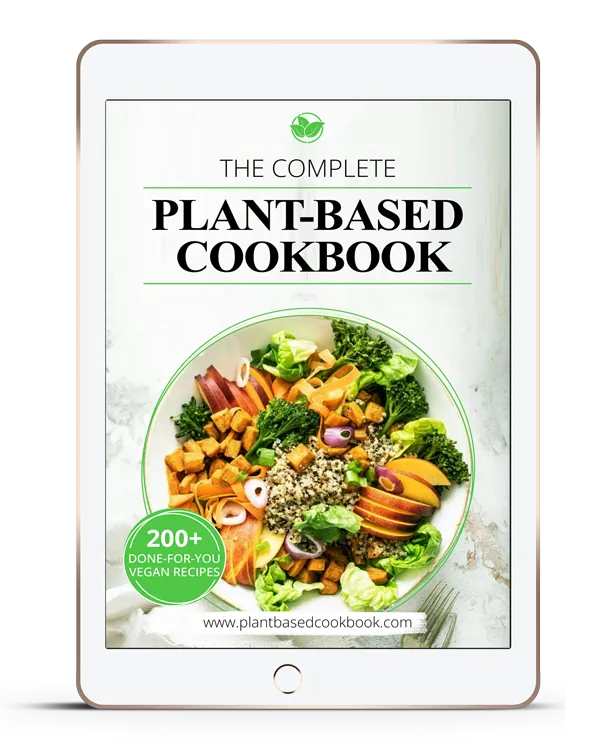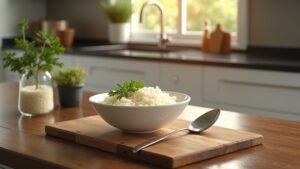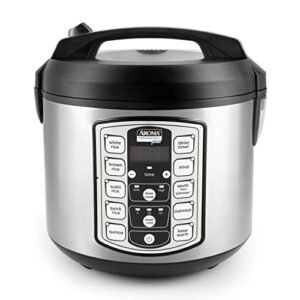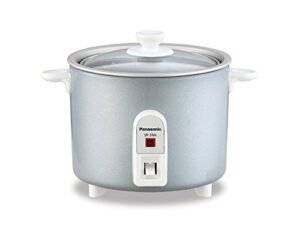While many of us know quinoa as an ancient superfood, we might not realize that this versatile grain actually comes from the same family as spinach and beets. For those of us looking to incorporate more of this protein-rich seed into our diets, a rice cooker offers one of the most foolproof ways to achieve perfect results. We'll show you how to transform these tiny seeds into fluffy, nutritious perfection with minimal effort, and share the essential tips that make the difference between mushy disappointment and restaurant-quality quinoa. Let's reveal the secrets to mastering this simple yet game-changing cooking method.
Table of Contents
ToggleBenefits of Cooking Quinoa in a Rice Cooker
Let's explore why cooking quinoa in a rice cooker is a game-changer for meal prep, offering us consistent, fluffy results while freeing up valuable stovetop space.
Unlike traditional stovetop methods that require constant monitoring, a rice cooker gives us perfectly cooked quinoa every time with just the push of a button.
We can even prepare other components of our meal while the rice cooker handles the quinoa, making it a more efficient option than both stovetop and Instant Pot cooking methods.
Why Choose a Rice Cooker for Quinoa
If you're tired of watching your stovetop like a hawk while cooking quinoa, a rice cooker offers the perfect solution.
We love using a rice cooker because it delivers consistently perfect results every time, taking the guesswork out of preparing this nutritious grain.
What's especially appealing about using a rice cooker for quinoa is how convenient it makes meal preparation.
We can set it and forget it while focusing on other dishes, knowing our quinoa will turn out light and fluffy without any risk of burning.
The rice cooker maintains the ideal temperature throughout the cooking process, and there's no need to monitor or adjust settings.
Plus, we've found that the results are remarkably reliable – something that's not always guaranteed when cooking quinoa on the stovetop.
Advantages Over Stovetop and Instant Pot Methods
Building on the convenience of rice cooker preparation, cooking quinoa in a rice cooker offers several distinct advantages over both stovetop and Instant Pot methods.
We've found that rice cooker quinoa consistently delivers perfectly fluffy quinoa without the need for constant monitoring or temperature adjustments that stovetop cooking demands.
Unlike the Instant Pot, which requires precise timing and pressure release steps, the rice cooker automatically adjusts its cooking cycle and stops when your quinoa is done. This set-it-and-forget-it approach makes cooking quinoa more convenient while freeing up valuable stovetop space for other dishes.
We also appreciate how the rice cooker maintains the ideal temperature throughout the cooking process, preventing the common issues of burning or undercooking that can occur with other methods.
Ease of Meal Prep with a Rice Cooker
A rice cooker's automated approach to cooking quinoa revolutionizes meal preparation by eliminating the need for constant attention. We love how it maintains the perfect cooking ratio while freeing up valuable stovetop space for other meal prep tasks. There's no need to monitor temperatures or worry about burning – the rice cooker handles everything automatically.
The convenience doesn't stop there. Once we've mastered this hands-off method, we can easily prepare quinoa for various dishes throughout the week. It's incredibly versatile, working perfectly in salads, grain bowls, and as a protein-rich side dish.
The consistent results mean we'll always have perfectly fluffy quinoa ready for our planned meals. Plus, the straightforward process makes it easier to maintain healthy eating habits while managing busy schedules.
Choosing the Right Quinoa
When we're preparing quinoa in our rice cooker, we'll find several varieties to choose from, including white, red, black, and tri-colored options, each offering distinct flavors and textures.
We'll want to assess whether our quinoa is pre-rinsed, as unrinsed quinoa requires thorough washing to remove its bitter coating called saponin.
White quinoa cooks fastest and turns out fluffiest in our rice cooker, while red and black varieties need slightly longer cooking times but hold their shape better for salads and heartier dishes.
Types of Quinoa: White, Red, Black, and Tri-Colored
Several distinct types of quinoa offer unique characteristics that can elevate your rice cooker dishes. White quinoa, the most commonly found variety, provides a mild flavor and fluffy texture that's perfect for everyday cooking.
If you're looking for something with more character, red quinoa delivers an earthier taste and maintains its shape well throughout the cooking process.
Black quinoa brings a sweet, earthy profile to the table and won't break down in salads or side dishes, making it an excellent choice for cold preparations.
For the best of all worlds, we recommend trying tri-colored quinoa, which combines white, red, and black varieties. This blend creates an engaging mix of textures and flavors while adding visual appeal to any dish you're preparing in your rice cooker.
Understanding Quinoa Varieties and Cooking Times
Choosing the right quinoa variety for your rice cooker can greatly impact your final dish's taste, texture, and cooking time. Let's explore the main varieties and their cooking characteristics so you'll know exactly what to expect.
The three most common quinoa varieties offer distinct qualities:
- White quinoa cooks fastest (15-20 minutes) and produces light, fluffy results that work well in most dishes
- Red quinoa delivers a nuttier flavor, maintains its shape better, and requires slightly more cooking time
- Black quinoa has a sweet undertone with a crunchier bite, needing the longest cooking time
We recommend starting with white quinoa if you're new to rice cooker preparation, as it's the most forgiving variety. Once you're comfortable with the basic cooking times, experiment with red and black varieties to discover your preferred taste and texture.
Selecting Pre-Rinsed vs. Unrinsed Quinoa
Making an informed decision between pre-washed and unwashed quinoa can significantly impact your rice cooker results. Pre-washed quinoa offers convenience by eliminating the need for washing before cooking, making it an excellent choice when we're short on time. This variety comes ready to use straight from the package while maintaining peak taste.
Unwashed quinoa, on the other hand, requires a thorough rinsing step to remove its natural saponin coating, which can cause bitterness in the final dish. While this extra preparation step takes more time, some cooks prefer having control over the rinsing process.
We recommend choosing pre-washed quinoa if convenience is your priority, but if you don't mind the additional step and want to optimize a thorough rinse, traditional unwashed quinoa works just as well in your rice cooker.
Preparing Quinoa for Cooking

Let's start with the essential step of rinsing quinoa under cold water to remove bitter compounds and saponins, using a fine-mesh strainer for the best results.
We can improve our quinoa's digestibility by soaking it for a few hours before cooking, though this step is optional for those short on time.
Before adding our rinsed quinoa to the rice cooker, we'll want to lightly spray or brush the inner pot with oil to prevent sticking and guarantee perfectly fluffy results.
Rinsing Quinoa: Importance and Techniques
Rinsing quinoa is an initial first step that removes the naturally occurring bitter compounds called saponins from the grain's surface. This cleaning process isn't just about taste – it's vital for achieving the perfect texture in your finished dish. We'll want to use a fine-mesh strainer for the best rinsing techniques.
Here's how to properly rinse your quinoa:
- Place quinoa in a fine-mesh strainer and hold it under cold running water
- Gently rub the quinoa between your fingers while rinsing to make sure thorough cleaning
- Continue rinsing until the water runs clear, usually about 1-2 minutes
The significance of this step can't be overstated – properly rinsed quinoa cooks more evenly, prevents clumping, and results in a lighter, fluffier texture that you'll definitely notice in your finished dish.
Soaking Quinoa: Optional Steps for Enhanced Digestibility
Soaking quinoa represents an optional but beneficial step in your preparation process. While not required, we recommend soaking quinoa for about 3 hours before cooking if you're looking to maximize its nutritional benefits. This optional step can notably improve digestibility and reduce any residual bitterness in the grain.
When you soak quinoa, you're helping to break down phytic acid, a compound that can interfere with mineral absorption in your body. We've found that soaking also contributes to a lighter, fluffier texture in the final dish.
If you decide to include this step, simply submerge your quinoa in water for 3 hours before cooking. Remember, while enhanced digestibility is a valuable benefit, you can still prepare delicious quinoa without soaking – it's entirely up to your preferences and schedule.
Greasing the Rice Cooker for Non-Stick Quinoa
Preparation of a non-stick surface is necessary before adding quinoa to your rice cooker. To achieve perfectly fluffy quinoa that doesn't stick to the bottom, we'll need to properly grease the inner pot of our cooker.
Let's secure our quinoa cooking success with these vital greasing steps:
- Spray a light, even coating of olive oil or coconut oil across the bottom and sides of the rice cooker's inner pot
- Use a paper towel to spread the oil evenly, securing complete coverage without excess pooling
- Pay special attention to the bottom corners where quinoa is most likely to stick
This simple greasing process creates a protective barrier between the quinoa and the cooking surface, preventing burning and sticking while maintaining the grain's fluffy texture throughout the cooking process.
Quinoa to Water Ratio
We'll start with the foundational ratio of 1 cup quinoa to 2 cups water, which gives us perfectly fluffy results in our rice cooker every time.
While this standard ratio works well for most varieties, we might need to adjust slightly depending on whether we're using white, red, or black quinoa.
For extra flavor, we can replace some or all of the water with vegetable broth, chicken stock, or even fruit juice while maintaining the same 1:2 proportion.
Standard 1:2 Quinoa to Water Ratio
For perfectly cooked quinoa in your rice cooker, follow the standard ratio of one part quinoa to two parts water. This quinoa to water ratio guarantees consistent results every time, ensuring a fluffy texture that's neither too wet nor too dry. If you'd like to enhance the flavor, try using broth instead of water while maintaining the same proportions.
When cooking in a rice cooker, you'll notice these visual cues that indicate proper ratios:
- The water level should be roughly double the height of the quinoa
- The quinoa should float freely without being crowded
- The liquid should cover all grains with room to expand
While we recommend starting with the standard ratio, you can experiment with adjusting water amount slightly based on your texture preferences, adding or reducing by 1-2 tablespoons per cup.
Adjusting Ratios for Different Quinoa Types
While the standard 1:2 ratio works well for white quinoa, different quinoa varieties require specific water adjustments to achieve best results. We'll need to modify our water ratio when cooking red quinoa or black quinoa in a rice cooker to guarantee proper texture and doneness.
For red quinoa, we recommend increasing the water ratio to 1:2.25, as this variety tends to be slightly denser and requires additional moisture during the cooking process.
Black quinoa needs even more water, with an ideal ratio of 1:2.5. These adjustments are essential because different quinoa types absorb water at varying rates.
When we're working with multiple quinoa varieties, it's worth experimenting with these ratios to find the perfect balance for our preferred texture and consistency.
Using Broth or Juice for Added Flavor
Transforming plain quinoa into a more flavorful dish starts with replacing water with broth or juice in your rice cooker. The cooking process remains exactly the same – just swap out the liquid while maintaining your usual ratio. We can enhance our quinoa's taste profile without any extra effort or complexity.
When selecting your cooking liquid, consider these flavor-boosting options:
- Chicken or vegetable broth for a savory, rich undertone perfect for dinner dishes
- Beef broth for a heartier, more robust taste that complements meaty meals
- Apple or orange juice for a subtle sweetness ideal for breakfast bowls
The beauty of this method is its simplicity – we're not adding any steps to our usual rice cooker routine, just exchanging one liquid for another to create more dynamic, tastier quinoa dishes.
Cooking Quinoa in a Rice Cooker
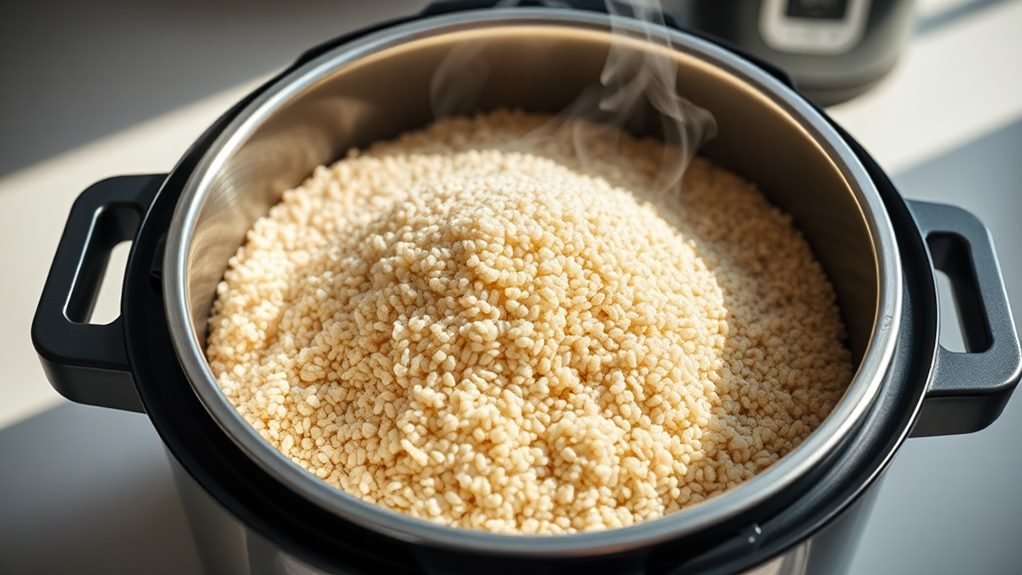
Let's look at how to set your rice cooker properly for perfect quinoa results.
We'll use the white rice setting for most quinoa varieties, which typically need 15-20 minutes to cook completely.
While red and black quinoa may require slightly longer cooking times, you can still use the same setting – just let the cooker run through an additional cycle if the grains aren't tender enough after the first round.
Selecting the Right Rice Cooker Setting
Success in cooking quinoa using a rice cooker largely depends on selecting the right setting. When cooking quinoa, we'll want to use the white rice setting, as it provides the ideal cooking time and temperature for perfect results.
The white rice setting works best for quinoa because:
- It maintains consistent heat that matches quinoa's cooking requirements
- It prevents overcooking and keeps grains from becoming mushy
- It secures the quinoa seeds remain separate and fluffy when done
We've found that this setting delivers reliable results every time, giving us perfectly cooked quinoa with a tender texture.
While some rice cookers offer multiple options, we don't need to overthink it – the white rice setting is our go-to choice for consistently great quinoa that's neither undercooked nor mushy.
Cooking Times for Different Quinoa Varieties
Once you've selected the white rice setting, understanding the cooking times for different quinoa varieties helps guarantee perfect results. White quinoa cooks the fastest at around 15 minutes, making it an excellent choice for quick meals.
If you're preparing brown quinoa, expect it to take slightly longer at 18-19 minutes, while black quinoa needs 20-21 minutes to cook thoroughly.
Remember that these cooking times may vary depending on your specific rice cooker model, but you'll always want to maintain the same liquid ratio: 2 cups of water or broth for every 1 cup of quinoa.
We suggest experimenting with your rice cooker to find the perfect timing, as some models might cook slightly faster or slower than others. You'll know it's done when the quinoa is fluffy and tender.
Tips for Perfect Quinoa
Let's explore some key tips for achieving perfect quinoa every time, starting with how to properly fluff the grains with a fork after cooking and let them steam briefly with the lid on.
We'll look at the best practices for cooling quinoa completely before storing it in airtight containers in the refrigerator, where it'll stay fresh for up to five days.
Once you've mastered the basics, we'll share creative ways to enhance your quinoa with seasonings and mix-ins, from fresh herbs and citrus to toasted nuts and roasted vegetables.
Fluffing Quinoa After Cooking
Properly fluffing your quinoa is an essential final step that transforms good quinoa into perfect quinoa. We'll want to gently fluff our cooked quinoa with a fork to separate grains and prevent clumping, ensuring that light and fluffy texture we're all aiming for.
Let's visualize the perfect fluffing technique:
- Wait until your rice cooker signals the quinoa is done cooking
- Remove the lid and let the steam escape for about 30 seconds
- Use a fork (never a spoon) to gently lift and separate the grains with light, upward motions
When we're fluffing quinoa, we're not just improving its texture – we're also helping it cool evenly and creating the perfect foundation for any seasonings or ingredients we'll add later.
Cooling and Storing Cooked Quinoa
The final steps of cooling and storing your quinoa are just as essential as the cooking process itself. We'll want to let our cooked quinoa cool completely to avoid condensation before storing it. Once cooled, transfer it to an airtight container for the fridge, where it'll keep for up to 4 days.
| Storage Method | Duration | Tips |
|---|---|---|
| Refrigerator | 4 days | Use airtight container |
| Freezer | 3 months | Use freezer-safe bag |
| Room Temp | Not recommended | Always refrigerate |
When you're ready to enjoy your stored quinoa, simply reheat it with a splash of water in the microwave, stirring occasionally. For longer-term storage, we recommend freezing your cooked quinoa in sealed containers or freezer bags, where it'll maintain quality for up to 3 months.
Adding Seasonings and Mix-ins
Enhancing your quinoa's flavor profile starts with thoughtful seasoning and creative mix-ins. We'll show you how to transform plain quinoa into a delightful dish bursting with flavor. Instead of using plain water, try cooking your quinoa in broth for an instantly richer taste, then add a drizzle of olive oil for creaminess.
Consider these flavor-boosting combinations:
- Mediterranean style: dried oregano, fresh basil, diced tomatoes, and a splash of olive oil
- Middle Eastern flair: ground cumin, paprika, toasted pine nuts, and fresh herbs
- Sweet and savory: dried cranberries, toasted almonds, and fresh thyme
Don't forget to season with salt and pepper before cooking. For added texture and nutrition, mix in your favorite diced vegetables once the quinoa has finished cooking.
Common Mistakes and Troubleshooting

Let's look at the most common mistakes when cooking quinoa in a rice cooker and how to fix them.
We'll go over timing issues that lead to overcooked or undercooked quinoa, what to do when quinoa sticks to the bottom of the pot, and how to achieve the right texture every time.
If you're experiencing any of these problems, you're not alone – they're easily fixable with a few adjustments to your cooking technique.
Avoiding Overcooking and Undercooking
Perfect timing plays a crucial role in achieving properly cooked quinoa in your rice cooker. We'll want to aim for about 30 minutes of cooking time to prevent overcooking or undercooking. If you notice your quinoa is undercooked, don't worry – just add a small amount of liquid and continue cooking until it's done.
To ensure consistently perfect quinoa, follow these key steps:
- Keep the lid closed during the entire cooking process to prevent mushy results
- Use the accurate liquid-to-quinoa ratio from the start
- Fluff the cooked quinoa with a fork to enhance texture
Dealing with Stuck or Burnt Quinoa
Even with careful timing and proper ratios, you might occasionally encounter stuck or burnt quinoa in your rice cooker. When this happens, don't scrape the bottom of the pot, as this can damage the coating. Instead, let the stuck quinoa soak in water to naturally loosen.
To prevent sticking and burning in future batches, we recommend a few simple steps.
- Always spray or coat your rice cooker with oil before adding quinoa.
- If you notice consistent problems, adjust your water-to-quinoa ratio, as insufficient liquid is often the culprit.
- Consider soaking your quinoa before cooking – this extra step can substantially reduce the chances of both sticking and burning.
Remember that burnt quinoa usually results from three main factors: not enough liquid, heat that's too high, or skipping the pre-cooking rinse.
Solving Texture Issues
Achieving the right texture with rice cooker quinoa can challenge even experienced cooks. We often see three common issues that affect the final result:
- Too much water creates mushy quinoa that clumps together
- Too little water leads to dry, undercooked grains that taste crunchy
- Incorrect cooking time results in either hard or overly soft texture
Let's solve these texture problems together. If your quinoa's too wet, simply leave the lid off for a few minutes to help excess moisture evaporate.
When it's too dry, try adjusting your water ratio or reducing the cooking time on your next batch. Remember to always fluff your quinoa with a fork after cooking – this simple step helps separate the grains and creates that perfect, fluffy texture we're looking for.
Meal Prep Ideas with Cooked Quinoa
Let's explore some clever ways to use our rice cooker-prepared quinoa for easy meal prep throughout the week.
We can create vibrant salad bowls packed with fresh vegetables and proteins, or use the quinoa as a nutritious stuffing for bell peppers, tomatoes, and wrap sandwiches.
The versatility of quinoa makes it an excellent base for countless dishes, from breakfast power bowls to hearty dinner entrées that'll keep us satisfied and energized.
Salads and Bowls
With quinoa cooked perfectly in your rice cooker, you're ready to create vibrant salads and nourishing grain bowls perfect for meal prep. These versatile meals let's combine protein-rich quinoa with endless ingredient combinations to keep our weekly menu exciting and nutritious.
Let's transform your quinoa into satisfying dishes with these meal prep-friendly ideas:
- Create a Mediterranean quinoa salad with cherry tomatoes, cucumber, feta cheese, and lemony dressing
- Build colorful grain bowls with roasted vegetables, grilled chicken, and tahini sauce
- Mix up a Southwest-style bowl featuring black beans, corn, avocado, and cilantro lime dressing
We love how these combinations offer complete nutrition while keeping our meals interesting. When we've prepped our quinoa in the rice cooker, assembling these dishes becomes quick and effortless for the week ahead.
Stuffed Vegetables and Wraps
Building on our rice cooker quinoa success, stuffed vegetables and wraps offer another delicious way to transform this versatile grain into satisfying meals. When we cook quinoa in advance, we're setting ourselves up for quick and nutritious meal options throughout the week.
| Meal Type | Prep Tips |
|---|---|
| Bell Peppers | Mix cooked quinoa with herbs and spices |
| Zucchini Boats | Combine with roasted vegetables |
| Stuffed Tomatoes | Add fresh herbs and protein |
| Lunch Wraps | Layer with fresh vegetables |
Let's maximize our meal prepping efforts by preparing a large batch of quinoa at once. We can then use it to create protein-rich stuffed vegetables or convenient wraps. The beauty of these options lies in their versatility – we can customize the fillings based on seasonal produce and personal preferences while maintaining the protein-packed quinoa base.
Quinoa as a Base for Various Dishes
After mastering stuffed vegetables and wraps, we can expand our quinoa repertoire even further by using this protein-rich grain as a foundation for countless dishes. Once we've cooked our quinoa in the rice cooker, we'll have a versatile base that's ready to transform into exciting meals.
Let's explore three popular ways to incorporate cooked quinoa into our weekly meal prep:
- Create vibrant breakfast options by mixing quinoa into morning scrambles or baking it into banana muffins
- Build nutritious lunch bowls with pomegranate quinoa salad or edamame quinoa combinations
- Prepare hearty dinner recipes like broccoli quinoa casseroles or veggie burgers
We can also use our cooked quinoa as a healthy base for chili, soups, and various side dishes, making it an essential ingredient for creative, nutrient-rich meals.
Nutritional Benefits of Quinoa
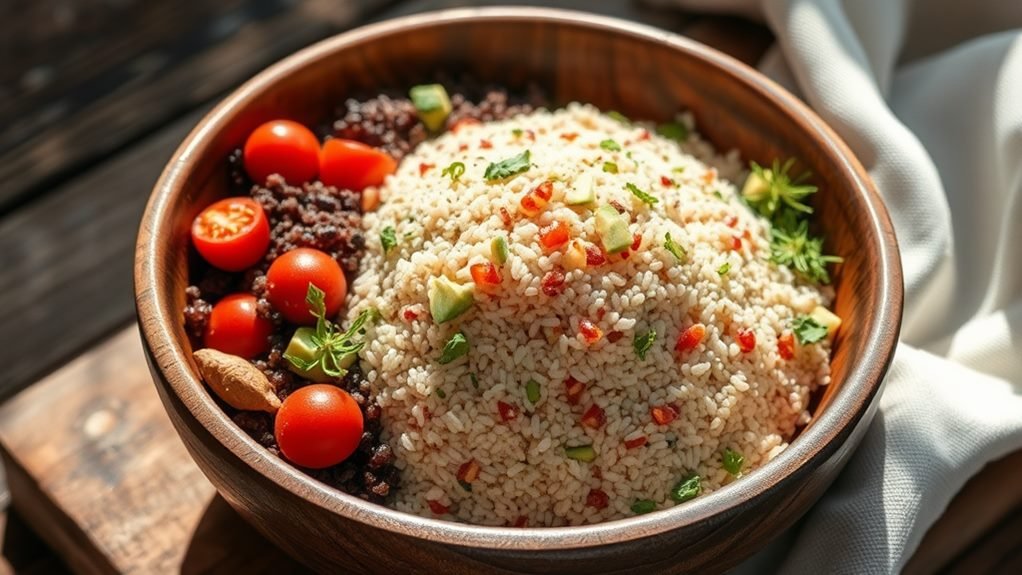
Let's look at why quinoa is a powerhouse of nutrition, starting with its status as a complete protein containing all nine essential amino acids our bodies need.
We're getting an impressive bundle of nutrients in each serving, including high levels of fiber, magnesium, B vitamins, and essential minerals like iron and potassium.
Adding quinoa to our daily meals is a smart way to boost our nutrition, whether we're mixing it into salads, serving it as a side dish, or using it as a base for healthy meal prep.
Quinoa as a Complete Protein
Protein powerhouse quinoa stands out among grains as one of nature's most complete protein sources. Unlike many plant-based foods, this nutrient-rich superfood contains all nine essential amino acids our bodies need but can't produce on their own.
We're especially excited about quinoa's versatility as a gluten-free option that supports overall health and wellness.
When we incorporate quinoa into our meals, we get:
- A complete protein source that rivals animal products
- Essential nutrients like iron and magnesium for comprehensive body function
- A filling, fiber-rich grain that helps maintain steady blood sugar levels
We can't overstate how rare it's to find a plant-based food that delivers such all-inclusive nutrition. If you're looking to boost your protein intake while managing gluten sensitivity, quinoa offers an ideal solution.
High Fiber and Mineral Content
Beyond its impressive protein profile, quinoa packs a powerful punch when it comes to fiber and essential minerals. When we cook this versatile grain, we're getting about 5 grams of fiber per cup, which helps support our digestive health and keeps our gut happy.
We'll also benefit from quinoa's rich mineral content, including magnesium, iron, and zinc – nutrients that are essential for maintaining our energy levels and immune system.
What's more, quinoa is loaded with protective antioxidants like flavonoids and quercetin, which help fight inflammation in our bodies and protect us from chronic diseases.
Since it's naturally gluten-free, we can confidently serve quinoa to friends and family with celiac disease or gluten sensitivities, making it a wonderfully inclusive addition to any meal.
Incorporating Quinoa into a Healthy Diet
A cornerstone of healthy eating, quinoa offers exceptional versatility while delivering outstanding nutritional benefits. Whether you're following a vegetarian or gluten-free diet, cooking quinoa in a rice cooker provides a convenient way to incorporate this nutrient-dense grain into your healthy diet.
We can enhance our daily nutrition by using quinoa in these simple ways:
- Replace traditional rice with quinoa as a side dish to boost protein and fiber intake
- Add cooked quinoa to salads and Buddha bowls for sustained energy
- Mix quinoa into breakfast porridge for a complete protein start to your day
As a low glycemic food rich in essential minerals, quinoa helps manage blood sugar levels while keeping us feeling full longer. It's particularly valuable for those seeking balanced nutrition without compromising on taste or convenience.
Conclusion: Mastering Quinoa in a Rice Cooker
We've discovered how simple and rewarding it's to master quinoa preparation using a rice cooker, transforming this ancient grain into perfectly fluffy results every time.
By experimenting with different broths, seasonings, and mix-ins, we can create countless variations to keep our meals interesting and nutritious.
Let's make rice cooker quinoa a regular part of our meal planning, knowing we've a foolproof method that delivers consistent results while freeing up our time and stovetop space.
Key Takeaways for Perfect Quinoa
Through mastering these necessary steps, you'll consistently achieve ideal quinoa in your rice cooker. We've learned that success starts with rinsing quinoa thoroughly to remove any bitter taste. Remember to maintain the 1:2 quinoa to water ratio for best results, and don't hesitate to experiment with different liquids like broth to enhance flavor.
For the best texture and taste, follow these essential steps:
- Spray the cooker's inner pot with oil to prevent sticking
- Let the quinoa steam after cooking for 5-10 minutes with the lid closed
- Fluff gently with a fork before serving
We've found that using the white rice setting works perfectly, but always check your specific rice cooker's instructions. With these techniques, you'll create fluffy, nutritious quinoa every time.
Experimenting with Different Recipes
Creativity blossoms once you've mastered the basics of cooking quinoa in your rice cooker.
We've found that quinoa recipes can extend far beyond simple side dishes, with options ranging from breakfast scrambles to hearty meatballs and flavorful jambalaya.
Whether you're using a rice cooker or exploring Instant Pot quinoa, maintaining the proper quinoa to water ratio is essential for success.
For convenient meal prep, try preparing large batches of quinoa and transforming them into crunchy salads or casseroles throughout the week.
We recommend checking user feedback on various recipes to discover new combinations and cooking techniques.
Making Quinoa a Staple in Your Kitchen
With proper technique and a reliable rice cooker, making quinoa can become as natural as brewing your morning coffee. By mastering quinoa in a rice cooker, we'll enjoy hands-off cooking that delivers consistent results every time.
Let's make quinoa a staple in your kitchen by focusing on these key benefits:
- We can set up the rice cooker in the morning, head to work, and return to perfectly cooked quinoa
- We'll save valuable stovetop space for other dishes while the quinoa cooks effortlessly
- We're guaranteed fluffy, well-cooked quinoa without the need to monitor or adjust heat settings
Cooking quinoa this way eliminates the guesswork and transforms this nutritious grain from an occasional side dish into a regular part of our weekly meal planning.


